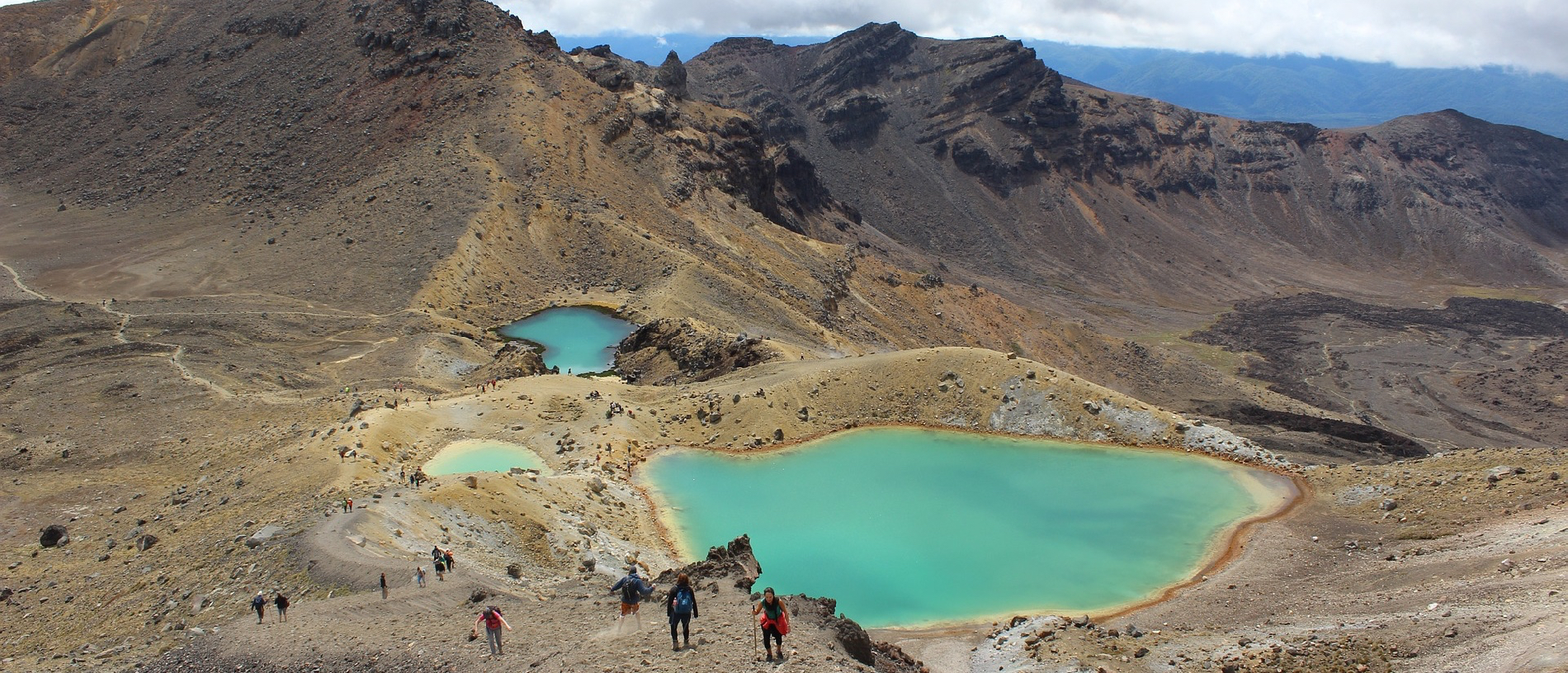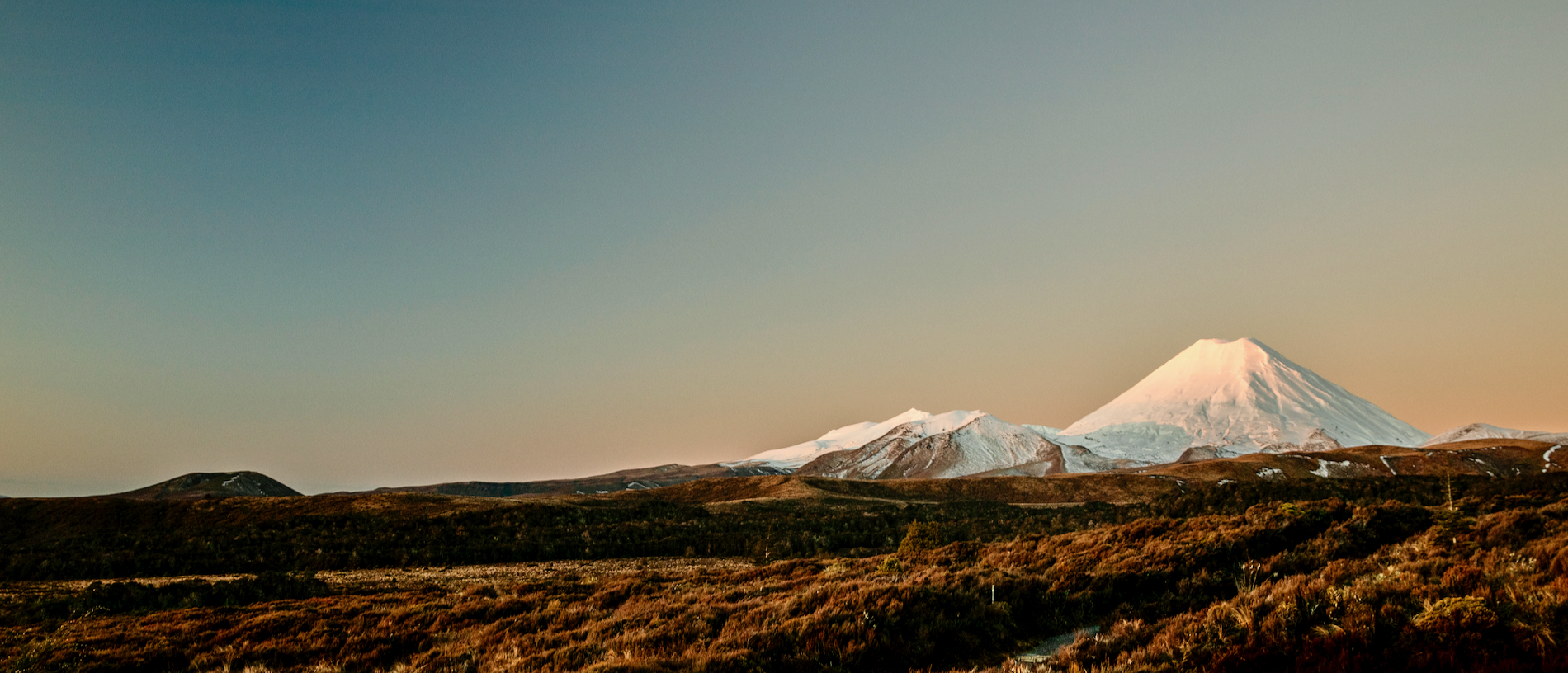
Tongariro Northern Circuit: alpine heartland
The Tongariro Northern Circuit explores a landscape of stark glacial contrasts and alpine views, with craters, explosion pits and lava flows aplenty.

The broad area around Tongariro National Park must have been a majestic place when Māori enjoyed undisturbed possession.
It’s still majestic today, even after the logging frenzy that all but wiped out the mature forest. You can get a glimpse of the grandeur that was in the Pureora Forest Park on the district’s northern boundary. The park was saved by dedicated conservationists in the late 1970s who managed to stop the extraction of the last remnants of original forest. Just how dedicated they were you can see for yourself: the treetop platforms on which the protestors sat day and night in order to prevent logging are still there, along with some of the heavy gear the foresters couldn’t be bothered bringing out when logging was prohibited.
Just out of the boundary of the park, you’ll find New Zealand’s largest living totara tree, Pouakani. There is some lovely walking to be done in the Pureora and if you want something a bit racier, you could try the Timber Trail mountain bike track.
The relatively vital state of the forest means there is a healthy population of birds here, too, including the rare kōkako, with its haunting call.
If you’re approaching Tongariro from the north, you might want to drop in on little Ōwhango, a former timber town which has become a bit of a holiday spot for those who want a toehold handy to the winter delights of the mountains. It’s a pretty town, with bush and birds, largely thanks to the preservation of the Ōhinetonga Scenic Reserve, through which kayakers on the Tongariro River pass enthralled, often making it their lunch stop.
The nominal capital of the district is National Park Village, formerly known as Waimarino, back in the days when it was a timber camp. It has the distinction of being the highest urban settlement in the North Island, and its raison d’etre is its prime location between Whanganui National Park to its west and the even higher ground to its east – Tongariro National Park. National Park is an accommodation hub and starting place for all sorts of adventures in the district: skiing and snowboarding, of course, but also tramping (most notably the ridiculously popular Tongariro Crossing), mountain biking, rafting, canyoning, angling and just about anything else mountain, lake or river-related you care to mention. National Park is also the gateway to this district if you’re travelling by rail.
The area was opened up to full-scale exploitation when the engineering marvel that is the Raurimu Spiral completed the North Island Main Trunk Line in 1908. National Park’s beautiful little station is still a popular stop on your Northern Explorer journey between Auckland and Wellington.
Even if you’re not planning on making the slightly hairy journey down the river road to Whanganui – although you really should – it’s worth venturing west to the little town of Raetihi.
Raetihi was a significant town in the timber days because it was at the crossroads of most of the tracks and what passed for roads. Its glory days were at the turn of last century, when it was thriving at the end of its own, busy railway branch, but its decline was steep after the twin catastrophes of a fire that destroyed as many as 200 houses and then the Spanish Flu epidemic, which hit the town hard, both in 1918.
The railway line wasn’t closed until 1968 after the last of the mills had stopped working, but Raetihi had fallen quiet long before. Today, it is enjoying something of a resurgence due to tourism. It is a setting-off point for jet boaters, trampers and mountain bikers – the superb, Mountains-to-Sea Cycle Trail, which stitches together many of the major attractions of the Whanganui National Park on the three-day pedal to Whanganui itself, sets off from here. The trail includes a jetboat ride along an otherwise impassable 31-km stretch of the river, which you need to book in advance.
While in Raetihi, visit the Waimarino Museum, a precinct of restored heritage buildings with a fascinating collection of artefacts and photographs of the district’s formative years.
Between National Park and Raetihi, you’ll find Horopito Motors, made famous by the 1981 movie, Smash Palace and featuring more recently in Hunt For the Wilderpeople. Anyone who owns a classic car will likely know the place: it was started by mechanic Bill Cole in the 1940s, and his policy of never throwing a car part away has created the largest collection of dismantled and partially dismantled automobiles in the Southern Hemisphere. Cole’s daughter and her husband have continued the legacy.
Even if you’re not motor-minded, Horopito Motors is worth a visit. It’s a photographer’s dream, acres of sculpted steel shapes artfully softened by rust.
If you’re heading for the ski slopes from National Park, you’re almost certain to aim for the Bruce Road, leading to the closer of the two ski fields operated by Ruapehu Alpine Lifts, Whakapapa. There’s an excellent campground at Whakapapa Village, offering some of the cheapest accommodation on the mountain if you’re adequately equipped for the climate. There’s also a great visitor’s centre, which is an essential stop for those intending to walk or tramp in the park, where conditions can change from gloriously fine to life-threateningly cold in a matter of half an hour.
Over on the other side of State Highway 47 from Mount Ruapehu is the Tongariro Forest, through which yet another superb mountain bike trail runs, the 42 Traverse. The annual T42, a mountain bike race along this route, is one of the circuits marked on the calendars of serious riders and marathon runners, but it’s fun at any time of the year. It’s not particularly technical but covers undulating ground with some steep and rough sections. As with everything in this area, beware of sudden changes in the weather.
To the north-west of Tongariro National Park is the forgotten mountain of the volcanic plateau, Mount Pihanga. According to Māori legend, Pihanga was the female vertex in a complicated romantic set-up involving Ruapehu, Tongariro and Taranaki. One day, the volatile Ruapehu warned Pihanga’s other suitors, Tongariro and Taranaki, to beat it or suffer the consequences in the morning.
Taranaki decided discretion was the better part of valour and made it all the way to the western extremity of the North Island. Tongariro was stauncher, and in the morning, when Ruapehu blew his top, he was still there, right beside Ruapehu and Pihanga, and was petrified forever.
The saddle over Pihanga takes you to Tūrangi and Lake Taupō, but on this road, you’ll find a little side-track to the very pretty Lake Rotopounamu, bush-fringed and a lovely place to enjoy a picnic and birdsong, or a swim in the soft, tannin-stained waters.
At the southern edge of Tongariro National Park, you’ll come to Ōhakune, New Zealand’s carrot capital, on account of the volume of the root vegetables it supplies. Ōhakune is on our list of Big Things, thanks to the giant fibreglass carrot situated there: this was apparently a prop in 1984 television advertisement but was snaffled by Ōhakune’s visionary town fathers when surplus to requirements.
Ōhakune was originally a railwayman’s camp but owed much of its original prosperity to the timber boom. These days, like everything else in the district, it is tourism that oils the wheels.
Ōhakune is handy to the road leading to the Turoa skifield and serves as an apres-ski venue and dormitory town to all those ski-bunnies and board-dudes. You wouldn’t believe the name translates to ‘place of the careful ones’ if you saw what they got up to in the powder.
Speaking of powder, Ōhakune’s Powderkeg Restaurant and Bar, part of the Powderhorn Chateau complex, has achieved icon status as the place to talk up your exploits over a gluwein or a Jaegermeister after the event. It occupies the former home of F J Carter, a pioneer timber miller whose surname is synonymous with the timber and construction industries in New Zealand.
Even in summer, there’s plenty to do in and around Ōhakune. It’s the start of the 15-km Old Coach Road, yet another of the excellent mountain bike trails in the district and the Turoa Road is a pretty fair ride, too. It’s also a great place to base yourself if you’re doing one of the many walks (yeah, yeah, including the Crossing) in the Tongariro National Park, and you’re also on the doorstep of the Whanganui National Park.
Not far from Ōhakune is Waiouru, which is not one, but two towns, really. One town is a truck stop and flophouse for the many, many big rigs that play the main north-south highway. The other is the military town association with the big army training ground that was established here just before World War II. Once, everyone inducted into the Army passed through here. Believe it or not, much of the training for troops sent to the jungles of South-East Asia was provided in Waiouru, amongst the sub-alpine tundra. But training operations have been progressively relocated and the town’s population has dwindled accordingly.
Still here, and really the centrepiece of Waiouru these days, is the Army Museum, which is a must-see – even for people who imagine they have no interest in things military.
Our nation’s history is intimately entwined with that of our armed forces: very few families do not have a reason to call one of the many wars their own, due to the sacrifice of an ancestor.
Between Waiouru and Ōhakune, you’ll pass Tangiwai, the scene in 1953 of one of the more freakish volcanic disasters in modern history. A lahar (volcanic mudslide) triggered by a low-level eruption of Ruapehu's crater lake wiped out a rail bridge over the river. A Wellington-Auckland express train carrying people heading home for the holidays plunged into the river in darkness on Christmas Eve, with the loss of 152 lives.
North of Waiouru is the Desert Road, which is an actual semi-arid desert. It’s one of the loveliest stretches of road in a nation abundant in lovely roads, best tackled early morning or evening when the sun is low and the sere tussock is gilded by the light. In clear conditions, with the majestic bulk of Ruapehu in full snow looming above the plains, it is incomparable. Little wonder it served as scenery in Peter Jackson’s Lord of the Rings movie series.
There are walks and longer, more serious tramps in the Tongariro National Park to be done from the Desert Road and in the other direction, the Kaimanawa Ranges, which are a playground for hunters and outdoorsmen alike. So rich are the outdoor opportunities that the Sir Edmund Hillary Outdoor Pursuits Centre is located here. You can learn to do all kinds of rugged stuff but, since 2008, not canyoning, which ceased in the wake of a tragedy in nearby Tree Trunk Gorge on the Tongariro River – a reminder that even the experts can misjudge the dynamic conditions of this special place.
Even doing something as mundane as driving from A to B is fraught with extraordinary risk from time to time: the roads (and especially the Desert Road) is prone to the formation of ‘black ice’ overnight when temperatures fall.